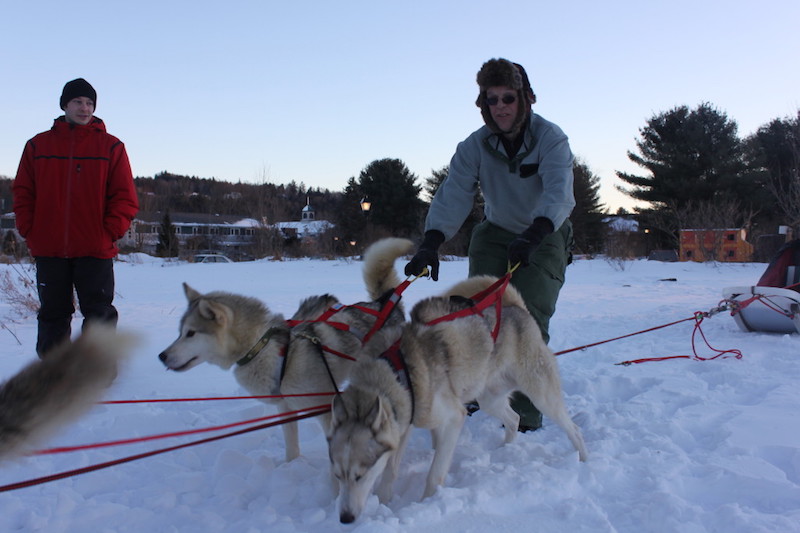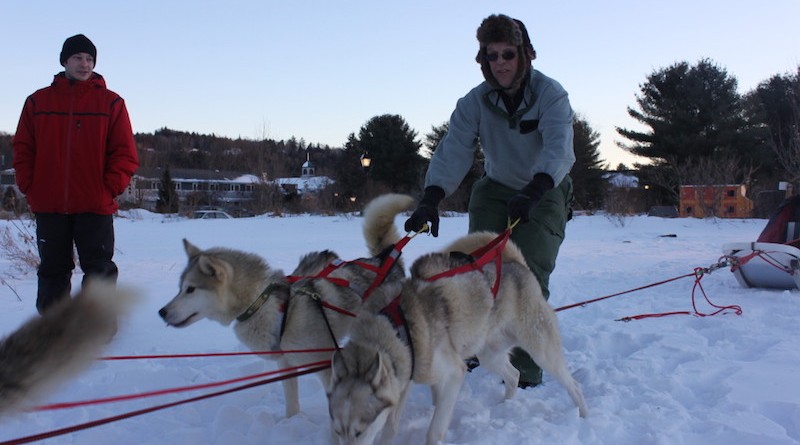Rob Farley, October Siberians Run Through Winter

Vermonter Rob Farley started out as a husky lover, but soon turned that passion into a lifestyle and a part-time business.
STOWE — You can hear the racket as soon as you turn into the parking lot of the Stoweflake Resort and Spa, the excited howls of 14 huskies eager to run.
Rob Farley and his dogs are in back of the Stoweflake Inn in Stowe, getting ready for another tour.
A big man with an easy-going attitude, Farley gently unloads each dog from the mobile kennel built into the back of his truck, talking to them while he clips them onto two cables running the length of the truck as they continue to howl, bark and whine.
“These guys get pretty excited because they know where they’re going,” he says, hurrying to set up his sled and the harnesses. “It’s hard for them to wait.”
Farley, 53, is the owner and head-musher for October Siberians, a kennel he started and has managed since 1994.While working fulltime for the Vermont Department of Environmental Conservation, his kennel has extended its lineage and has recently welcomed its fourth generation. Today, he has 18 and a quarter dogs (that last quarter is a Norfolk terrier, which mostly stays inside).
The story of October Siberians started more than 20 years ago when he got his first Husky, a loveable Siberian named Thyme. Another puppy arrived soon after that. A year later, he had five more.
At the time, Farley’s intent was to assemble a team of dogs for the Sandwich Notch 60, a 60-mile race in Sandwich, N.H. for sleds of six to eight dogs. The race seemed like a good place for a beginner to start.
“Six dogs doesn’t seem like a lot of dogs,” he says. “And 60 miles is not the Iditarod, but it’s a good long day on the trail. For me, my first goal was to get a team together.”
Farley completed the race, first participating in a 30-mile version, then when he had enough dogs, worked his way up to the full 60-mile race over the next two years. For those first years, it was just a hobby for when he wasn’t working as a scientist for the state.
When they had enough dogs, he, his wife Elly and daughter Sage, decided to turn the hobby into a part-time business. In 2005, they began offering rides at the Stoweflake Resort and more extended tours at Little River State Park in Waterbury under the name October Siberians. The name holds significance; Farley and his wife met, got their first Siberian and had their first litter of pups all in Octobers over a couple of years.
Creating a line of dogs is an involved process and Farley takes dog breeding seriously. There are a number of bloodlines that breeders follow and Farley’s lines of choice are Anadyr and White Water Lake, two older lineages that a breeder in Ontario, Canada provides.
“We’re not trying to develop our own line of dogs,” he says. “We’re looking for really good-natured, hardworking dogs with great personality. They’re well behaved and easy to work with.”
The combination of features is a result of their training as well as their pedigree, something, he says, is seldom found at other kennels.
“If you go to other kennels and races, dogs are screaming,” he says. “They’re trying to yank the sled loose and get going. My dogs get on the line and they hang out and wait until they get the command to go.”
As the musher, Farley stays at the head of the kennel as the leader, but under him exists a pack hierarchy that is constantly changing.
“It’s been interesting to see how it changes,” he says. “My first dog, Thyme, was alpha when he was around. What happens with these alpha dogs is, as they get older, a younger dog will fill-in beneath him. So the dogs still give him the respect he’s due, but there’s someone younger who is running the show.”
Meanwhile, the females have a pecking order all their own. His female alpha dog (the pack has both male and female leaders) is much like her grandmother and doesn’t hesitate to show she’s boss, he says.
“You don’t cross her,” Farley cautions.
Meanwhile, the kennel’s six youngest dogs are just over a year old and are beginning to learn their place. Some are beginning to assert themselves in surprising ways, sometimes usurping their parents.
Farley knows this because of his observations, by spending time with the dogs everyday and caring for them from birth all the way until the end of their careers. Having spent so much time around them, he’s in tune with each of their personalities. Zappa, the alpha dog, lacks the confidence of his father but is far more affectionate. Layla has a reputation as one of the “party girls” and Belle is all sweetness until it’s time to run.
“There’s a lot of strong personalities here,” he says. “They’re all characters.”
Farley’s interactions with the dogs reflect the bond he has with them. While he zips around the fields behind the Stowehof, he instructs them in a calm and benevolent tone. The dogs obey the commands he calls out from the sled. While they were barking like mad in the parking lot just a few minutes ago, when they’re running, they’re quiet and focused.
Farley says he continues to mush out of a love for the dogs and their willingness to work hard for him.
“I’m someone who thinks that every dog has its job to do,” he says. “This is a dog that’s been bred for hundreds of years to be a working dog. This isn’t a dog that’s meant to just sit around. If you give them the opportunity, they’ll get the job done for you.”

